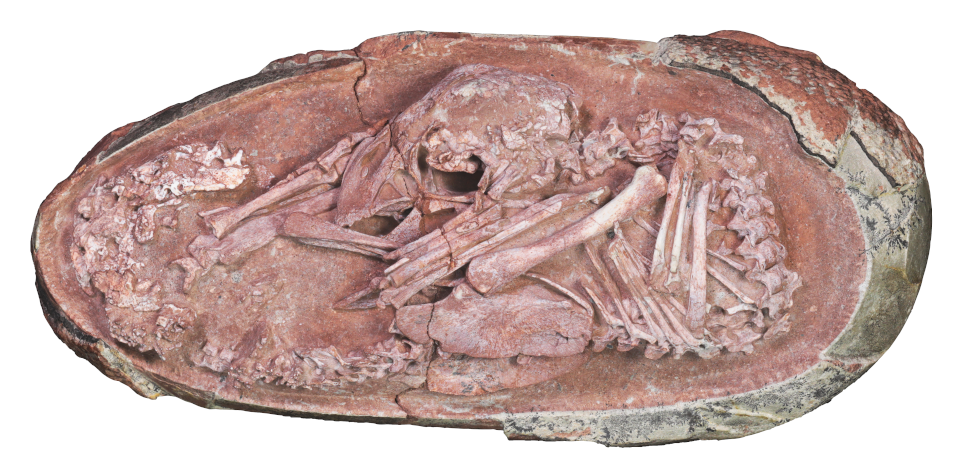The rare fossil embryo of an oviraptor is revealing a surprising connection between the hatching behaviour of dinosaurs and modern birds, according to new research.
A clutch of unhatched dinosaur eggs, though not formally identified as such, was discovered in China’s Jiangxi province in 2000. The fossils, pulled from the Late Cretaceous Hekou Formation of southern China, promptly ended up in storage and were largely forgotten. It was only during construction of the Yingliang Stone Nature History Museum in the 2010s that museum staff, after sorting through the storage, rediscovered the specimen, dated to between 66 million and 72 million years old.
These fossils were subsequently identified as dinosaur eggs, as Lida Xing, the first author of a new iScience paper describing the discovery, explained in a University of Birmingham press release. “Fossil preparation was conducted and eventually unveiled the embryo hidden inside the egg,” said Xing, a paleontologist at China University of Geosciences.

The fossilized embryo, dubbed “Baby Yingliang,” was identified as an oviraptor, a diverse group of feathered theropod dinosaurs closely related to modern birds. The discovery of a fossilized embryo is a rare occurrence, but Baby Yingliang is extra special on account of its bodily posture inside the 6.7-inch-long (17-centimeter) egg.
“This dinosaur embryo inside its egg is one of the most beautiful fossils I have ever seen,” Steve Brusatte, a co-author of the study and a paleontologist at the University of Edinburgh, said in the press release. “This little prenatal dinosaur looks just like a baby bird curled in its egg, which is yet more evidence that many features characteristic of today’s birds first evolved in their dinosaur ancestors.”
Indeed, analysis of the embryo showed it to be in a tight fetal position, with its head tucked into the body and spine nestled along the curvature of the egg shell. Uncurled, it would be 10.6 inches long (27 cm). Scientists refer to this as “tucking” behaviour, which is observed in modern birds.
In an email, Fion Waisum Ma, a paleobiology PhD student at the University of Birmingham and a co-author of the new study, said this posture “is similar to a close-to-hatching modern bird embryo” and “similar to a 17-day-old chicken embryo,” which tend to hatch on day 21.
Tucking is triggered by the developing embryo’s central nervous system and is deemed critical for hatching success. The final position prior to hatching “has been suggested to help stabilise and direct the head, when the bird is cracking the eggshell using its beak,” Ma explained. “Failure to achieve this final position would lower the chance of successful hatching, and the bird would die inside the egg.”
This fossil, therefore, suggests a potential evolutionary link between the hatching behaviour of dinosaurs, specifically non-avian dinosaurs (as evidenced in this case), and modern birds (also known as avian dinosaurs — and yes, all birds are dinosaurs).
“Tucking was previously considered unique to birds, but our findings suggest theropod dinosaurs like [oviraptors] could have had this behaviour as well,” said Ma. “This indicates tucking behaviour in modern birds could have first evolved among their dinosaurian ancestors.”
It’s an intriguing finding, but Shundong Bi, a paleontologist at Indiana University of Pennsylvania who wasn’t involved in the new study, isn’t convinced. “I am sceptical about the tucking behaviour as it is primarily based on a single specimen,” Bi explained in an email.
The air cell, or air pocket, within an egg quickly expands in the days prior to hatching, and it’s where a developing embryo takes its first breath. The authors of the new study interpreted the space between the embryo’s spine and the blunt pole of the egg (the larger end of the egg) as the air cell observed in modern bird eggs, but Bi said it’s not clear that’s what the fossil shows.
Recognising the small sample size of one, the team is hoping that similar fossils will eventually come to light. Additional evidence would do much to strengthen this theory, that tucking originated or was at least present among non-avian theropods. Looking ahead to future research, the team would like to inspect the fossil with different imaging techniques “to look inside the specimen and study its anatomy in more detail,” said Ma. That’s good news, as Baby Yingliang could have more stories to tell.
More: Extraordinary Fossil Captures Nesting Oviraptor Dinosaur Alongside Unhatched Offspring.
